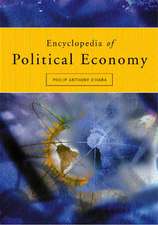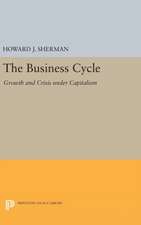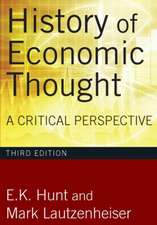Economics: An Introduction to Traditional and Progressive Views: An Introduction to Traditional and Progressive Views
Autor Howard J Sherman, E. K. Hunt, Reynold F. Nesiba, Phillip O'Hara, Barbara A. Wiens-Tuersen Limba Engleză Paperback – 15 apr 2008
| Toate formatele și edițiile | Preț | Express |
|---|---|---|
| Paperback (1) | 505.91 lei 6-8 săpt. | |
| Taylor & Francis – 15 apr 2008 | 505.91 lei 6-8 săpt. | |
| Hardback (1) | 1005.66 lei 6-8 săpt. | |
| Taylor & Francis – 29 iul 2016 | 1005.66 lei 6-8 săpt. |
Preț: 505.91 lei
Nou
Puncte Express: 759
Preț estimativ în valută:
96.81€ • 103.52$ • 80.71£
96.81€ • 103.52$ • 80.71£
Carte tipărită la comandă
Livrare economică 17 aprilie-01 mai
Preluare comenzi: 021 569.72.76
Specificații
ISBN-13: 9780765616685
ISBN-10: 0765616688
Pagini: 760
Ilustrații: tables, figures, instructor's manual, end-of-chapter questions, key words, summary points, glossary, bibliography, index
Dimensiuni: 178 x 254 x 45 mm
Greutate: 1.32 kg
Ediția:7th edition
Editura: Taylor & Francis
Colecția Routledge
Locul publicării:Oxford, United Kingdom
ISBN-10: 0765616688
Pagini: 760
Ilustrații: tables, figures, instructor's manual, end-of-chapter questions, key words, summary points, glossary, bibliography, index
Dimensiuni: 178 x 254 x 45 mm
Greutate: 1.32 kg
Ediția:7th edition
Editura: Taylor & Francis
Colecția Routledge
Locul publicării:Oxford, United Kingdom
Notă biografică
Sherman, Howard J; Hunt, E. K.; Nesiba, Reynold F.; O'Hara, Phillip; Wiens-Tuers, Barbara A.
Cuprins
Foreword by Robert Pollin, Preface, Acknowledgments, PART I. ECONOMICS OF HISTORY AND HISTORY OF ECONOMICS, Section 1. The Long Road to Capitalism, 1. Prehistoric Communal Institutions in the Middle East, 2. Communal Equality to Slavery in the Middle East, 3. Slavery to Feudalism in Western Europe, 4. Feudalism and Paternalism in England, 5. Feudalism to Capitalism in England, 6. Mercantilism in England, 7. Pre-Capitalism to Industrial Capitalism in the United States, 1776–1865, Section 2. Capitalism, Its Defenders, and Its Critics, 8. Classical Liberalism: Defense of Industrial Capitalism, 9. Socialist Protest Against Industrial Capitalism, 10. Marx: Critique and Alternative to Capitalism, 11. Rise of Corporate Capitalism in the United States, 1865–1900, 12. Neoclassical Economics: Defense of Corporate Capitalism, 13. Veblen: Critique of Corporate Capitalism, 14. Growth and Depression in the United States, 1900–1940, 15. Keynesian Economics and the Great Depression, 16. The United States and Global Capitalism, 1940–2006, PART II. MICROECONOMICS: PRICES, PROFITS, AND POVERTY, Section 1. Introduction, 17. Robinson Crusoe: Two Perspectives on Microeconomics, Section 2. Elements of Progressive Microeconomics, 18. The Two Americas: Inequality, Class, and Conflict, 19. Inequality, Exploitation, and Economic Institutions, 20. Prices, Profits, and Exploitation, 21. Market Power and Global Corporations, Section 3. Applications of Progressive Microeconomics, 22. Economics of Racial and Gender Discrimination, 23. Environmental Devastation, 24. Government and Inequality, 25. Economic Democracy, Section 4. Elements of Neoclassical Economics, 26. Scarcity and Choice: Neoclassical View, 27. Simple Analytics of Supply and Demand, 28. Consumption Theory: Demand, 29. Production Theory: Supply, 30. Costs of Production, 31. Work and Wages: Neoclassical View of Income Distribution, Section 5. Neoclassical Approach to Market Structure and Market Failure, 32. Prices and Profits in Perfect Competition, 33. Monopoly Power, Prices, and Profits, 34. Monopolistic Competition and Oligopoly, 35. Market Failures: Public Goods, Market Power, and Externalities, PART III. MACROECONOMICS: GROWTH AND STABILITY, Section 1. Aggregate Supply and Demand, 36. History of Business Cycles and Human Misery, 37. National Income Accounting: How to Map the Circulation of Money and Goods, 38. Money and Profit: Say’s Law and Institutionalist Criticism, 39. Neoclassical View of Aggregate Supply and Demand, 40. Keynesian View of Aggregate Supply and Demand, Section 2. Understanding Instability, 41. How to Measure Instability, 42. Consumer Spending and Labor Income, 43. Investment Spending and Profit, 44. The Multiplier, 45. Business Cycles and Unemployment, 46. Growth and Waste, Section 3. Government Fiscal Policy, 47. Fiscal Policy, 48. Government Spending and Taxes, Section 4. Money and Monetary Policy, 49. Money, Banking, and Credit, 50. Inflation, 51. Monetary Policy, PART IV. INTERNATIONAL AND GLOBAL POLICY, 52. Exports and Imports, 53. International Trade, Investment, and Finance: How Instability Spreads Around the World, 54. Debate on Globalization, 55. Debate on Free Trade, 56. Development, Glossary, References, Index
Descriere
Introduces students to both traditional economic views and their progressive critique. This book offers a discussion of economic history and the history of economic thought, including the ideas of Karl Marx, Thorstein Veblen, and John Maynard Keynes. It also includes pedagogical tools to encourage student participation and learning.

















